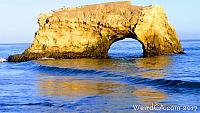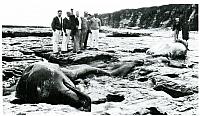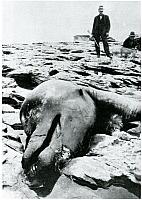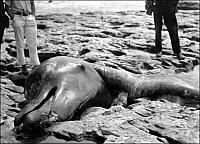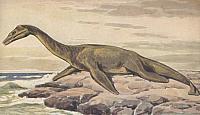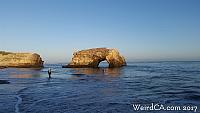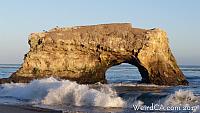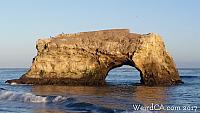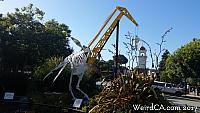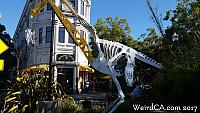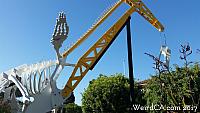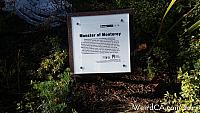Santa Cruz Sea Monster
 Natural Bridges State Beach
Natural Bridges State Beach
2531 W Cliff Dr,
Santa Cruz, California
95060
 Monster of Monterey Sculpture
Monster of Monterey Sculpture
Front Street and Pacific Avenue,
Santa Cruz, California
Sometime during late May 1925, perhaps very early June 1925, Santa Cruz was the center of attention when the body of a giant sea creature washed ashore at what is now known as Natural Bridges State Beach. (It was known as Moore's Beach back in 1925 after an Eli Moore who had a ranch along Moore Creek. The creek runs into the beach). The sea monster had a horrid smell, a duck-like head attached to a long neck, elephant like legs apparently with toenails, and a whale-like tale. Reports of its size varied, ranging anywhere from thirty to over fifty feet. It was supposedly discovered by one Charles Moore. And the monster became known as the Moore's Beach Monster or the Santa Cruz Sea Monster.
Although pictures of the creature exist, descriptions of the monster vary widely from one account to another. In one it is a serpent like monster, two feet in diameter, but fifty feet long. The snake like body had elephant like legs every few yards complete with ivory toenails. In many descriptions the creature had a duck like head, but in at least one, it had a head bigger than a barrel, with eyes bigger than abalone. The barrel headed version also had an oval shaped body with a seven foot long neck! Other descriptions are much more as one would consider a lake monster like the Loch Ness monster looking and acting.
But the story, of course, gets worse. The supposed President of the Natural History Society of British Columbia, one E.L. Wallace, appeared on the scene, for some reason, and he told the world that the carcass was that of the long extinct plesiosaur! Wallace's theory was that it had been stuck in ice, preserved in a glacier for over 65 million years. And that now the ice had recently melted, thus depositing the corpse of this Mesozoic marine reptile on the beach in Santa Cruz.
So this far fetched story of an ice encased plesiosaur, of course, made all the papers. The body of the sea creature was sent to the California Academy of Sciences in San Francisco, where the entire tall tale was soundly debunked as the corpse was found to be a Baird's Beaked Whale or Berardius bairdi, with the long neck just some blubber. Their findings were published in the Journal of Mammalogy. Earlier theories that the creature was, indeed, a plesiosaur, had been published far and wide, and this one article in the Journal which refuted those stories was unable to stop the momentum of the earlier false story.
Whoever the strange E.L. Wallace was, remains a mystery, as he's never been heard from since, nor had he ever been heard of before. He seems to simply only exist at this one point in history! No one has been able to confirm his real identity of his status as two time President of the Natural History Society of British Columbia. Whoever this mysterious man was, he certainly muddied the entire story though, as you can still find accounts, particularly online, that inaccurately describe the sea monster as a plesiosaur or some other strange creature instead of the correct Baird's Beaked Whale. In fact, it's still quite common to run across someone touting that a plesiosaur, perhaps one formerly encased in ice or perhaps one living in modern times, actually washed up in Santa Cruz in 1925. The theory that it was an ancient aquatic reptile is particularly popular amongst certain fringe religious types, such as Creationists who believe the Earth is only 5000 years old and that dinosaurs and man lived side by side.
Today the area is known as Natural Bridges State Park, after the arches that use to stick out into the ocean. There once were three arches reaching out into the waters, but now only one of these natural bridges remain, the former middle one. The closest arch to land fell away back in 1980 during a storm, while the furthest arch disappeared long before that. The state park was established in 1933. The beach was formerly named Moore's Beach. Moore Creek still runs off into the ocean at the site.
The California Academy of Sciences has the skull of the whale on display, supposedly in Cowell Hall.
As recently as 2017, downtown Santa Cruz still had an art sculpture called the "Monster of Monterey" in homage of the various sea monster myths that have been tossed around in the area. The sculpture depicts a pigeon skeleton combined with the boom of a crane, wearing the head, tail and flippers of a plesiosaur. The sculpture was done by Arnold Martin of Long Beach and installed in June of 2016. The sign for the sculpture reads:
Monster of Monterey
Plesiosauria Colomba domestica is inspired by the history, places and myths of Monterey Bay. Its humorous construction is taken from the 20th century stories of sea monsters found washed ashore. Its body is a larger than life pigeon skeleton combined with the tail, flippers and skull of a Plesiosaur suspended from the long boom of a luffing crane common to docks and ports. The sculpture is a hybrid built from disparate pieces just as myths are constructed from memories of everyday and unexplained experiences, fishing stories, and tall tales.
Follow WeirdCA.com!
Outside References:
- Weird California (2006) by Greg Bishop, Joe Oesterle, Mike Marinacci, p: 90
- Mysterious California (1988) by Marinacci, Mike, p: 49 - 51
- Strange California Monsters (2009) by Newton, Michael, p: 28 - 30
- Shipwrecks and Sea Monsters of California's Central Coast (1975) by Reinsted, Randall, p: 136, 159 - 166
- Mysterious Sea Monsters of California's Central Coast (1993) by Reinstedt, Randall A, p: 63 - 70
First Created: 2017-08-05
Last Edited: 2017-08-05



